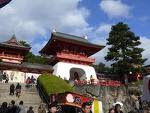[ . BACK to WORLDKIGO TOP . ]:::::::::::::::::::::::::::::::::::::::::::::::::::::::::::::::::::::::::::::::::::::::::::::::::::
Sentei Festival (senteisai)
***** Location: Shimonoseki, Japan
***** Season: Late Spring
***** Category: Observance *****************************
ExplanationSentei sai 先帝祭 (せんていさい) Sentei Festival
..... Sentei-e, Sentei e 先帝会(せんていえ)
sentei literally means "the former emperor"
Held at shrine Akama Jingu in Shimonoseki on May 2 to 4
In memory of a visit of Emperor Go-Toba to pray for the soul of Antoku Tenno at the temple Amida-Ji, on march 24 of the lunar calendar.
Also in rememberance of the ladies of the Heike clan who had to work as prostitutes to pay for the funerals of their family members.

During the procession, ladies dressed in robes of the Heian court parade through the city.
山口県下関市の赤間神宮
後鳥羽天皇 Gotoba Tenno
安徳天皇 Antoku Tenno
::::::::::::::::::::::::::::::::::::::::::::::::::::::::::::::::::::::::::::::::::::::::::::::::::
Emperor Antoku (安徳天皇 Antoku-tennō)
(December 22, 1178 – April 24, 1185, age 16)

was the 81st emperor of Japan, according to the traditional order of succession. His reign spanned the years from 1180 through 1185.
During this time, the imperial family was involved in a bitter struggle between warring clans. Yoritomo, with his cousin Yoshinaka, led a force from the Minamoto clan against the Taira, who controlled the emperor. During a sea battle in April 1185, a member of the royal household took Antoku and plunged with him into the water in the Shimonoseki Straits, drowning the child emperor rather than allowing him to be captured by the opposing forces.
The conflict between the clans led to numerous legends and tales. Antoku's tomb is said to be located in a number of places around western Japan, including the island of Iwo Jima, a result of the spreading of legends about the emperor and the battle.
1183 (Juei 2, 20th day of the 8th month):
Go-Toba is proclaimed emperor by the Genji; and consequently, there were two proclaimed emperors.
1185 (Genryaku 2, 24th day of the 3rd month):
The Taira (Heike) and the Minamoto clashed in the Battle of Dan-no-ura.
The Taira were defeated. Antoku's grandmother, Taira no Tokiko, the widow of Taira no Kiyomori, drowned herself along with the young emperor Antoku.
Memorial siteAfter his drowning, in order to mourn the body and placate any restless spirits, the Amidaji Goeidō 御影堂 was built. Later, Antoku was enshrined at the Kurume-Suitengū in Kurume, Fukuoka, and he came to be worshipped as Mizu-no-kami (水の神, lit. "water-god" or "god of water"), the god of easy delivery at Suitengū (水天宮, lit. "water-heaven/emperor-shrine") everywhere.
With the establishment of Shintō as the state religion of Japan, the Amidaji Temple was abandoned and the Akama Shrine was established in Shimonoseki, Yamaguchi to celebrate Antoku.
The Imperial Household Agency designates Amida-ji no misasagi (阿彌陀寺陵) near Akama Shrine in Shimonoseki, Yamaguchi as Antoku's tomb.
© More in the WIKIPEDIA !.................................................................................
 Akama Shrine (赤間神宮, Akama Jingū)
Akama Shrine (赤間神宮, Akama Jingū)
is a Shinto shrine in Shimonoseki, Yamaguchi Prefecture. It is dedicated to Antoku, a Japanese emperor who died young in the Battle of Dan-no-Ura (aka Dannoura), which occurred nearby in 1185.
© More in the WIKIPEDIA !.................................................................................

ema 絵馬 votive tablet
. denden daiko omamori でんでん太鼓 small drum. kani dorei カニ土鈴 clay bell like a crab
fugu dorei フク土鈴 clay bell like a pufferfish
fuusui omikuji 風水おみくじ feng shui amulets
Homepage of the shrine
source : jinja/xakama.htm . Amulets and Talismans from Japan . :::::::::::::::::::::::::::::::::::::::::::::::::::::::::::::::::::::::::::::::::::::::::::::::::::::
. Suitengu 水天宮 Shrine for the Water God . Deity in residence is Antoku Tenno 安徳天皇 .
***************************** Worldwide use*****************************
Things found on the wayIn the “Tales of Heike”the Kumano Betto Tanzo 熊野別当湛増 (or steward of the Kumano shrines, who is said to be the father of Benkei) turned to the gods to decide which side to join forces with during the historic sea battle of “Dan-no-ura” (1185) between the Heike and Genji clans by holding a divinatory cockfight here with a white and a red cock.
The white cock, representing the Genji, won the fight.
. Benkei Matsuri 弁慶まつり Benkei Festival . WASHOKU : Food from Shimonoseki *****************************
HAIKU春の潮先帝祭も近づきぬ
haru no shio sentei sai mo chikazukinu
spring tide -
the Sentei festival too
is coming closer
. Takahama Kyoshi高浜 虚子 *****************************Related words*****
. Taira no Tadanori 平忠度 BACK : Top of this Saijiki [ . BACK to WORLDKIGO . TOP . ]:::::::::::::::::::::::::::::::::::::::::::::::::::::::::::::::::::::::::::::::::::::::::::::::::::::


















